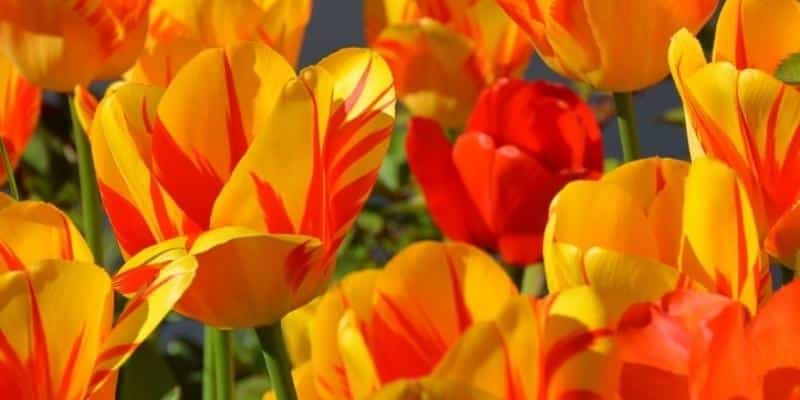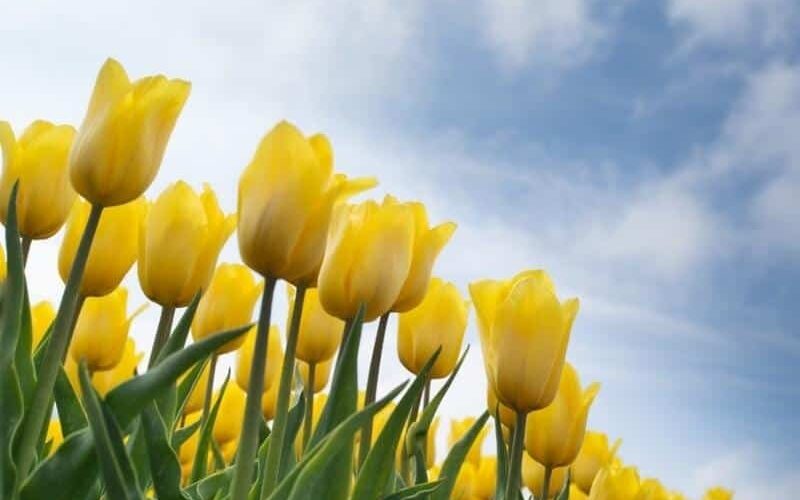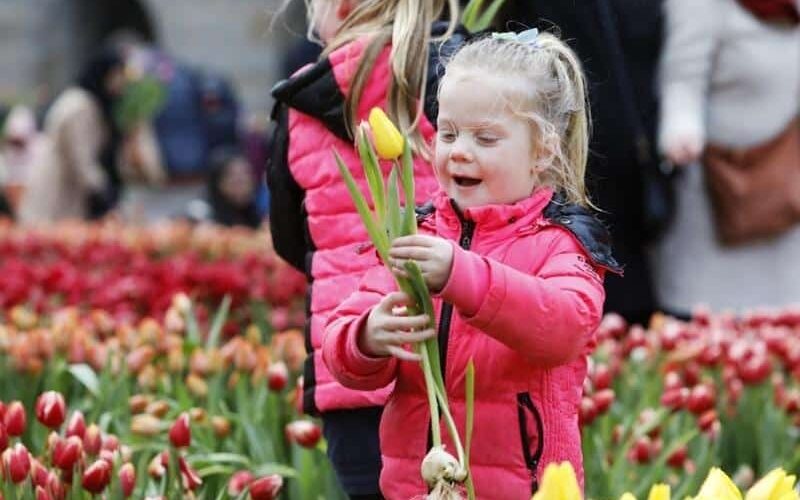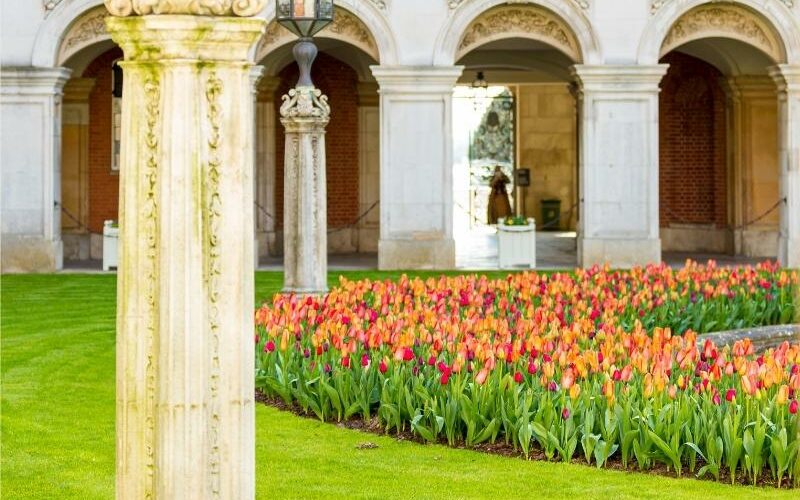Celebrating the tulip
You may wonder why the Dutch hold a National Tulip Day in January, when April and May are the months when tulips are normally in bloom. This is because the event is organised by Dutch tulip growers to promote the start of the cut tulip flower season. The bulbs are grown in greenhouses and are available as cut flowers from around the month of December.

There is, however, an Amsterdam Tulip Festival which takes place when the outdoor tulips are in bloom. In 2022 this will take place from 24th March to 15th May. At the same time the famous Keukenhof Tulip Gardens are at their best.

Keukenhof Tulip Gardens, Lisse, Netherlands
National Tulip Day January 15th
Did you know that January 15th is National Tulip Day (Nationale Tulipendag) in The Netherlands?
I hadn’t heard of the festival before, so I did a bit of research and found out that it always takes place on the third Saturday of the month in Dam square in the centre of Amsterdam, and that it has been taking place for the past ten years. More than 200,000 tulips will be planted in a temporary garden where visitors can normally pick their own tulips for free. However, due to COVID restrictions, it will not be possible to pick tulips in 2022. In spite of the restrictions, which were also in place last year, more than 15,000 people are expected to visit the festival in 2022.

Dam Square in the centre of Amsterdam during Tulip Day 2021
Photo courtesy of TPN/VidiFoto
Tulip Festivals in other countries
The Netherlands is not the only country where tulips are celebrated. Many cities in the USA with a Dutch heritage, such as Albany, New York, Holland, Michigan, Orange City, Iowa and Woodburn, Oregon also hold festivals. The festivals are often associated with the Dutch immigrants who brought the tulips there and started growing them.
Tulip festivals also take place in Brazil, Australia and New Zealand as well as in India and in Japan. In India the tulip festival is celebrated in April and held in the Indira Gandhi Memorial Tulip Garden in Srinagar in Kashmir, said to be the largest tulip garden in Asia spread over 30 hectares. The gardens were opened in 2007, when about 1.5 million tulips were brought from Keukenhof Tulip Gardens and planted there. The tulip festival has taken place every year since then and attracts tourists from all over the world:

Canada
The Canadian Tulip Festival, which claims to be the largest in the world, is held annually in May in Ottawa. The Dutch royal family were exiled in Ottawa during World War II and Princess Margriet of the Netherlands was born there. In gratitude to the Canadians, the royal family sent 100,000 tulip bulbs to Canada at the end of the war and continue to send bulbs to Canada for the tulip festival to this day. In 2022 the Festival will take place from 13th-23rd May in the Commissioner’s Park in Ottawa.

Tulips with the Canadian Parliament Building in the Background
Photograph courtesy of Ottawa Tourism
Australia
In Australia (where the seasons are the other way round!), the Tesselaar Tulip Festival will take place in Silvan, Victoria from 10th September to 9th October 2022.
The festival owes its origins to Cees and Johanna Tesselaar, a Dutch couple who left The Netherlands for Australia on their wedding day in 1939. They sailed on the “Strathallen”, one of the last ships to leave Europe before the start of the Second World War.
The Tesselaaars began growing bulbs near Melbourne, but eventually settled in Silvan where the rich volcanic soil and cool climate were ideal for growing bulbs. People would often stop to admire their tulip fields and eventually, in 1954, the Tesselaars decided to open their farm to the public. Entry was by a “silver coin” donation to the Red Cross
Over sixty years later the tulip festival is still going strong, although in 2020 and 2021 it could not be held because of COVID restrictions. It normally attracts about 100,000 people over the four weeks when it is open, and over 90,000 tulip bulbs are planted for the occasion.

Photo courtesy of Tesselaar Tulip Festival

Photo courtesy of Tesselaar Tulip Festival
Tulips in the United Kindom
One part of the UK which was famous for bulb growing (and, in particular, tulips) is the area around Spalding in Lincolnshire, known as the fens. This area was drained by Dutch engineers mainly in the seventeenth century and the reclaimed land proved to be highly fertile and ideal for growing bulbs. Commercial bulb growing in the area started in about 1890 and increased after the end of the First World War with the development of the dry bulb trade..
By the 1920’s and 1930’s huge expanses of land were devoted to bulb growing and the fame of the tulip fields spread. People would come to visit the colourful tulip fields and, on one occasion, fields were planted with red, white and blue tulips to honour the visit of King George V and Queen Mary.
In 1959 the first Spalding Flower Parade was held. Within three years the parade had become more popular than the flower fields themselves and by the early 1960’s over a quarter of a million people came to watch it each year.
Sadly, the last Spalding Flower Parade was held in 2013, 55 years after its inception. Farmers had turned away from bulb growing to more lucrative crops and the costs of putting on the parade had escalated. A smaller event is now held each year at Springfield Festival Gardens to the north of the town.

Hampton Court Tulip Festival
In April 2021 Hampton Court Palace held its first ever tulip festival. Tulips have been grown at the palace since the reign of Queen Mary in the seventeenth century, the era when the tulip became popular in Europe. Queen Mary’s husband was Prince William, Prince of Orange, and both he and the queen shared a love of gardening. They replanted the gardens at Hampton Court Palace in the Dutch style and some of the tulip varieties at Hampton Court are said to date back to their reign.
Over 100,000 tulips were planted for the 2021 Tulip Festival in 2021. Further tulip festivals will be held in the future.

Fountain Court, Hampton Court Palace
Photo © Historic Royal Palaces
Why The Tulip?
There cannot be many flowers that have been as celebrated as the tulip. What is it about the tulip that has led to its popularity and success? Perhaps it’s the fact that it appears early in the year and, planted in huge drifts, makes a spectacular sight with its huge range of colours and forms? Perhaps it’s due to its almost perfect symmetry. Although the blooms have three petals and three sepals, because the sepals are almost the same size and shape as the petals, tulips appear to have six petals to a bulb.

Pond Garden, Hampton Court Palace
Photo © Historic Royal Palaces
The fascination with tulips goes back a long way. It’s clear from the origins of the various tulip festivals around the world that the Dutch have played a great role in introducing the tulip to other parts of the world and still play an important role in its cultivation and popularity. However, the tulip has its origins in Central Asia, where it grew as a wild flower. It was first cultivated by the Turks from around 1,000 A.D. and remained an important part of the country’s culture. Suleiman the Magnificent, who ascended the throne in 1520, loved tulips. They appeared in embroidery on his clothes and his subjects had to supply him with large numbers of the bulbs. The early 18th Century was known as the “Tulip Era” (Lâle Devri) when the tulip was highly prized by high-class Ottoman society. Tulips had become a symbol of nobility and privilege and were often depicted in ceramic tiles, paintings and embroidery. By this time it was the long, slender blossom with pointed petals that was particularly favoured and used in illustrations.

To this day, Turkish Airlines carries a stylised image of a tulip on its aircraft and the tulip is the national flower of Turkey. Istanbul has its own tulip festival which usually takes place in April each year.
Tulips were introduced into Western Europe and the Netherlands in the late 16th century, by Carolus Clusius, a biologist from Vienna. Clusius moved to the University of Leiden in the Netherlands to research medicinal plants. While there he received some tulip bulbs from a friend in Turkey, and it was from here that the tulip’s connection with The Netherlands began.
The flowers were exotic and not like any other flowers ever seen before. The demand for tulips grew until people started to buy tulip bulbs at extortionate prices: this was the era of the so-called “tulipomania”. It is said that some tulips could command more than six times the average salary or the price of a house. The most expensive tulip, “Semper Augustus” was sold for 5,000 florins in 1637, the equivalent of $2,500 in 2013.

Turkish Tiles depicting Tulips
Inevitably, prices collapsed and the tulip trade ground to a halt. However, throughout the 17th and 18th centuries, interest in the tulip continued and the Dutch remained the connoisseurs and experts in bulb growing. The twentieth century saw further developments in hybridisation and today there are fifteen different tulip groups, each containing hundreds of different varieties.
Although tulipomania was fairly short-lived, the success of the Dutch in cultivating and exporting tulips has continued to this day. In 2020 the value of tulip bulb exports was just over 220 million euros. At first England was the main market, but the USA, Canada and Russia soon followed, especially once air travel made exporting to these countries much easier.

Semper Augustus, the most expensive tulip ever sold
So it’s not hard to see why the Dutch celebrate National Tulip Day and why countries around the world hold tulip festivals, many of them created by Dutch settlers and/or supplied by Dutch growers. The sight of thousands of colourful tulips in Dam Square in the middle of January must be a truly uplifting sight!

Photo courtesy of TPN/VidiFoto



About the Author
Caroline Bowman has been hooked on gardening ever since she grew some thyme from seed and planted it in a window box when she lived in a flat in London. Fifty years later she is still hooked on gardening, but now she lives in Lincolnshire in England where they have quite a big suburban garden as well as an allotment, where they grow fruit and vegetables. Caroline loves flowering plants, in particular, herbaceous perennials and she likes finding out about the more unusual varieties that will do well in the English climate and soil.
GARDENIZE GARDEN APP
A gardening friend with a green thumb and photographic memory
Gardenize is an app for gardening and cultivation that helps you to overview, understand and develop your garden and your gardening skills.
Order makes it easier to succeed and Gardenize structures information and photos and makes it searchable for you. You also get tips and inspiration from other Gardenizers around the world.
The basic functions of Gardenize are free to use and you can download Gardenize from the App Store or Google Play, or create an account the Gardenize web app for web browsers.
Get to know Gardenize better here.
More to read from Gardenize
Images published on the Gardenize website belong to Gardenize AB and may not be used without permission.



